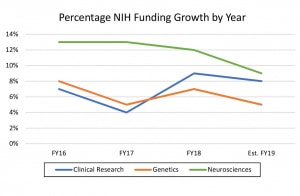Clinical Research Leads NIH Funding in Fiscal 2019
In fiscal year 2019 (FY19) (ending September 30), the budget for the NIH, the largest funder of biomedical research in the US, totaled $39,308 million, a 5.4% increase. But how is the NIH spending this money?
One way to measure the spending is by disease category. The NIH recently updated its data on its total annual fiscal year spending by categories of research, condition and disease. “The NIH’s Estimates of Funding for Various Research, Condition, and Disease Categories (RCDC)” table classifies NIH grants and contracts by 288 categories. Research maybe counted in multiple categories.
This blog concentrates of life science research categories, excluding categories largely devoted to behavioral or public health research, such as prevention and women’s health. The categories encompass specific disease types as well as general research areas. These categories are chosen because research funding for them directly effects the purchase of laboratory equipment and instruments. Among instrumentation whose sales have been tied to increase in NIH grants are next generation sequencers, electron microscopes and mass spectrometers.
Top Life Science Funding
According to the Table update published earlier this month, among life science research categories, Clinical Research was the largest recipient among all disease and conditions, with total estimated FY19 funding of $15,023 million, an 8.3% jump from a year ago. Although a significant step down in its total amount compared to Clinical Research, Genetics funding reached $9,551 million in FY19 for a 4.9% increase. Neurosciences received the third largest amount at $8,945 million, up 8.8%.
Other life science research categories receiving more than $5,000 million in NIH FY19 funding were Biotechnology with funding up 6.6% to $7,380 million. Research funding for Cancer (see below) and Brain Disorders (see below) each topped $6,000 million, as was also true for Infectious Disease funding, which was up 4.9% to $6,024 million for this fiscal year.
Fastest Life Science Funding Growth
However, the largest increases in estimated FY19 funding belonged to three different life science categories, all three of which target Alzheimers Disease. NIH funding for Alzheimer’s Disease Related Dementias, Alzheimer’s Disease including Alzheimer’s Disease Related Dementias, and Alzheimer’s Disease increased 30.0%, 29.1% and 28.8% to $503 million, $2,468 million and $2,305 million, respectively, in FY19. Likewise, spending to research and treat other neurological disorders received notable increases. Funding for Neurodegenerative Disease research and Neurofibromatosis research rose 9.6% and 9.2% to $57 million and $3,369 million, respectively.
As highlighted in a recent Congressional Research Report, Congress has prioritized Alzheimer’s research in its final budget appropriations for the NIH in recent years. In addition, specific programs have targeted neuroscience research, such as the Brain Research through Advancing Innovative Neurotechnologies (BRAIN) Initiative. BRAIN was allocated $1.5 billion in research funding from FY17 through FY26.
Also receiving double-digit percentage increases in funding for FY19 among life science research fields were Precision Medicine, with funding up 13.3% to $1,499 million, and Clinical Trials and Supportive Activities, for which funding rose 12.1% to $4,902 million. Part of the NIH’s Precision Medicine Initiative, the All of Us Research Program was allocated $1.5 billion for FY17–FY26.
Cancer Funding
Total NIH Cancer funding grew 4.3% to $6,610 billion in FY19. In addition, the Table also includes funding amounts for 10 specific types of cancer. Receiving the largest amount of NIH funding in FY19 was Breast Cancer at $743 million, followed by Pediatric Cancer at $595 million. Funding for each grew a respective 3.1% and 6.0% in FY19. The largest funding increases were reserved for Vaginal Cancer, up 8.3% to $13 million, and Pediatric Cancer, up 6.0% to $545 million. In contrast to the boost in neuroscience funding due to dedicated programs, the Beau Biden Cancer Moonshot, which was allocated $1.8 billion in funding from FY17 to FY23 for cancer research, has not translated into a funding boost for the overall field, according to the Table data.






